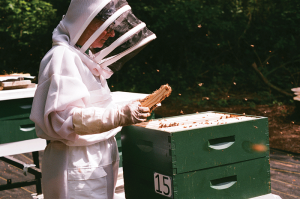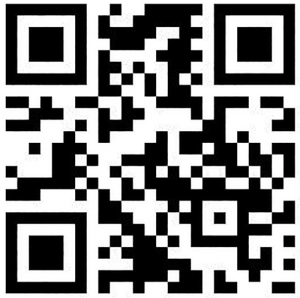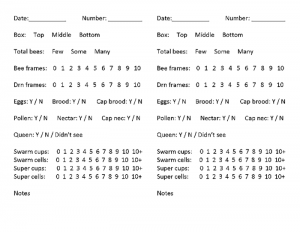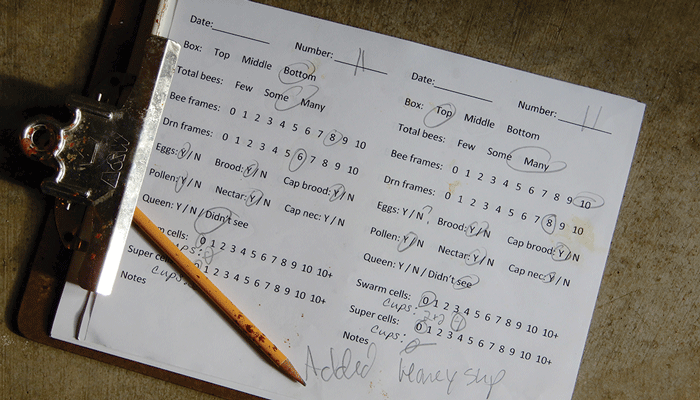By: Denise Ohio and Catherine Minden
Keeping Records
Beekeeping is a multisensory experience.
 You don’t just see the bees, you listen to them, you breathe in the scent of the hive: a mix of honey, propolis, and wood so strong you can taste it. You feel a bee walking on you or the sharp burn of a sting. It’s hot in a bee suit and veil, hair tickles your nose when you already need to sneeze, and sneezing inside the veil is a special experience. Beekeeping is so glamorous.
You don’t just see the bees, you listen to them, you breathe in the scent of the hive: a mix of honey, propolis, and wood so strong you can taste it. You feel a bee walking on you or the sharp burn of a sting. It’s hot in a bee suit and veil, hair tickles your nose when you already need to sneeze, and sneezing inside the veil is a special experience. Beekeeping is so glamorous.
This is part of why keeping bees is wonderful and why it’s easy to resent anything that gets in the way of that experience. Like record keeping.
Everyone talks about the importance of records, and we all know we’re supposed to do it. But record keeping is a challenge. It’s not clear what to track, how, or when. There’s a lot of possible data to gather, and it’s a pain to gather quickly, especially when you’re wearing a bee suit and gloves. And because it’s a pain and a nuisance, many people just don’t bother to do it.
But keeping records is a concrete way of tracking what you’ve done and what you’ve tried. It gives you a picture of your hives at a specific time as well as helps you see long-term patterns in queen productivity, disease outbreaks, and treatment effectiveness. Keeping records also allows you to be directed in your tasks. We all need to get into and out of the hive as quickly as possible. A quick review of your notes from a previous visit helps you get what you need to get done with minimal disruption.
Let’s say you’re committed to keeping records and you have the best of intentions. But how do you tackle this beast? As with most things, start by figuring out what your goals are. What information you track, how, and how often are all determined by what you need to help you achieve your goals. Perhaps this season you want to
- Test a new hive configuration or a new piece of equipment
- Produce more honey, beeswax, pollen, or nucs and queens
- Try a new location
- Expand your apiary
Whatever your goals are, ask yourself what you need to know to see if you’re getting there.
It’s easy to make grand plans to keep highly detailed, high-tech records when it’s winter and you’re sitting in a comfy chair, sipping cocoa and wearing bunny slippers. It’s a different story when it’s 94° in the beeyard and you’re sweating like people you read about in books. So as you think about what you absolutely need to know, also think about when you need to know it. For example, do you need weather data? Possibly yes, if you’re trying to figure out why a queen is underperforming and want to know if it was raining when she was ready for her mating flight, but you can get that from numerous websites when necessary. So do you need to record that info during every routine hive inspection? Probably not.
The idea here is to separate the data you could capture from the data you need to capture to get information that will help you help your bees.
Designing your plan of attack
Your approach to tracking hive activities doesn’t have to be complicated. Perhaps you just need a memory aid to help you remember what you have to do after an inspection. One beekeeper we know changes the positions of the bricks atop his hives to cue him about what’s going on inside. Another makes notes on duct tape on the top cover with a Sharpie.
While these methods are easy and don’t require expensive equipment – and some record keeping is better than none – they don’t give you much information over time. For example, how do these beekeepers prepare for the next hive inspection if the information about the last visit is in the beeyard? How do they compare what happened last season with this season? How do they track where they got their queens or when they treated for Varroa and with what? How do they remember which hive is the one with the frame that needs to be replaced?
The two biggest record-keeping issues are accuracy and timeliness. The information needs to be complete and recorded as close to real time as is practicable. (“Principles of Record-Keeping Practices” from the Canadian Food Inspection Agency website has many helpful suggestions.) “Real-time” and “accurate” are closely related. To keep real-time records requires tools that are easy to use, inexpensive, robust, and flexible enough to use on-site and that yield the results accurate enough to be useful.
We use a simple worksheet that we fill out during hive inspections. This is the information that helps us remember the status and day-to-day needs of a specific hive and helps us see patterns and changes over time. We keep a tight lid on what we track because anything that isn’t useful just gets in the way.
There are other worksheets available that you can find online (some are free and some you have to pay for). If they work for you, great. If not, figure out why not. Maybe a slight change would make them useful. Again, keep your goals in mind. The point is to gather what you need to know, when you need to know it, so you can see if you’re meeting your goals. See the sidebar, “Information is power,” for more.
Taking it high-tech
Some people swear that the best way to manage your record keeping is with an app. There are several available, with some by paid subscription. Many use cloud services to retain your data, so you can access the app and your data through any Internet-enabled device, which could be handy if you want to use such a device while working your bees.
A few things about these tools give us pause. First, if you can’t access the Internet or don’t have a cell signal in the yard, you may be out of luck. Several apps allow for offline use, but not all, so if your yard is out of range, the app won’t work. Also, some of these apps upload to the cloud whether you want to or not, and if you have limited data, you may incur fees.
Second, using apps in the field is messy. Literally. Take out a cell phone or other touch-enabled device and watch as it’s splattered with beeswax, pollen, nectar, and propolis. Trying to use a cell phone, much less a tablet, while working bees is clumsy. You’re holding a frame with a hive tool in one hand while the other hand is trying to thumb-tap notes on a sticky screen. Of course, you can wait until after you’ve finished your inspection to enter the data while still in the yard, but while nitrile gloves work fine on a Samsung Galaxy’s touch screen, crud-covered leather gloves don’t. You’d have to take them off to get the app in the beeyard to work and who has time for that?
And when you inevitably drop the device, better hope it doesn’t land in the middle of a full-to-bursting honey frame. (On the other hand, while you may have to deal with a record-setting level of stickiness, your phone will taste better than any cell phone on the planet. Just don’t be licking it in public because people will take video and post it on YouTube. While Internet fame sounds fun, do you really want to be known internationally as the Phone Licker?)
That said, apps could be useful in our apiary in the future, with a little further refinement and the ability to customize easily. One feature we’ll suggest to developers now is support for speech-to-text conversion with audio prompts. That way, you could keep your phone in your pocket and hear reminders about the tasks you need to do for a specific hive on that day, and be asked a set of questions, to which you reply from a set of given values, such as yes or no, or a number. That data could be dropped into a spreadsheet or other tool automatically for further analysis out of the hot sun.
Getting down to business
Regardless of the tools you use or the data you want to capture, you start by labeling each yard and hive, using a unique identifier for each. This can be as complex as you want.
If you want to use an app, you can use a Quick Response (QR) code or other barcode affixed to each hive. During hive inspections, you would take your cell phone or tablet out to the beeyard and scan the QR code, and the software will fetch the correct record. That’s pretty neat. You then complete the hive inspection tasks, make notes, add images, video, or audio, and the data is uploaded to the cloud for your later use.
 If you use a QR code, we recommend you use another, human-friendly label as well. It’s easier to refer to hives by a name or number than by a barcode.
If you use a QR code, we recommend you use another, human-friendly label as well. It’s easier to refer to hives by a name or number than by a barcode.
Use a naming scheme that makes sense to you and allows for expansion (through splits, packages, or captured swarms) and contraction (because of die-outs, combination, or sales). Back when we started beekeeping, we used to name our hives after TV characters. Interestingly, one of our most productive hives ever had a TV villain name and a personality to go along with it. Those bees were Hall-of-Fame level mean. But if you want to live on the edge and name a hive Voldemort, knock yourself out.
Our naming scheme is a lot less colorful now. Each yard is given a letter (A, B, or C). Each hive is given a number, which we print, laminate, and staple to the bottom super. (If your yards aren’t on your property, you may want to keep the address, directions, or GPS coordinates in an accessible place should someone else need them. Follow the “hit by a bus” rule: in case you get hit by a bus, be sure to leave information about important stuff so someone else can take over.)
 Next, equip yourself with whatever you’ll use for data capture during hive inspections or other beeyard visits. And if you use one of the pencil-and-paper worksheets, figure out what you’ll do with the information you gather so you can refer to it easily later. Again, this doesn’t have to be complicated. You could just collect the sheets into a notebook or binder. If the information you’re collecting is structured – mostly numbers and dates, rather than free-form notes – you can enter it into a spreadsheet program like Excel.
Next, equip yourself with whatever you’ll use for data capture during hive inspections or other beeyard visits. And if you use one of the pencil-and-paper worksheets, figure out what you’ll do with the information you gather so you can refer to it easily later. Again, this doesn’t have to be complicated. You could just collect the sheets into a notebook or binder. If the information you’re collecting is structured – mostly numbers and dates, rather than free-form notes – you can enter it into a spreadsheet program like Excel.
We use a combination of different but complementary tools. We use Excel spreadsheets to track the data we collect from our paper worksheet and to record the results of mite-monitoring tests. Some information collected from hive inspections goes into Microsoft OneNote, which is free-form, like a notebook, so we can record observations, hunches, questions, or even images or audio that might be interesting. (The Evernote app works in the same way.) We use a calendar app to schedule and remind us about hive inspection dates, mite-monitoring tests, supplemental feeding, and so on.
Of course, if you choose one of the beekeeping apps, it might be able to handle some or all your information and scheduling. Just be sure to have the app set up and ready to go before the information starts pouring in. And remember: you may need to change your record-keeping process as your needs change.
The fruits of your record-keeping labor
One of the immediate benefits of record keeping is that you’re more prepared every time you step into the beeyard. You can review the latest notes ahead of time to see what tasks need to be accomplished and if there are any areas of concern. Right before heading out to the beeyard, we jot down reminders on scrap paper, and then tuck them under the rock sitting atop the cover of the pertinent hive. This is a low-tech but timely way to remember anything beyond routine inspection tasks.
Over the course of a season, you’ll refer to your notes to track queen health, mite loads, temperament, whether a hive has adequate honey stores for winter, and so on.
Best of all, in the dead of winter, as you settle in your comfy chair with your bunny slippers and cocoa, you can review your records and find the scent and sounds of summer in your records.
Information is power
Just to get you started, here’s a list of things to include in your record keeping. You may want to track all of these things or just some, and you’ll probably have your own additions to the list.
- The data from routine hive inspections (the condition of the queen, does the hive have adequate stores for the time of year, any signs of swarming or supersedure, any evidence of disease)
- The results of mite monitoring (when you tested, with what method, and what were the results)
- Queen health and requeening activities (age of the queens, where the queens came from, results of requeening, and so on)
- Treatment activities (when you treated, which hives, and with what)
A few (not exhaustive) list of beekeeping apps
ApiTrack https://hikurangienterprises.files.wordpress.com
/2016/09/apitrack-summary-v1-2.pdf
BeeCloud http://beecloud.co/en/
Beehive Tracker https://play.google.com/store/apps/details
?id=appinventor.ai_aesrabingol.bee
Beetight https://www.beetight.com/
Hive Tracks https://hivetracks.com/
My Beekeeper https://www.mybeekeeper.com/
Worksheets
You can download our worksheet from the Bee Culture website www.BeeCulture.com.
Dadant Hive Inspection Sheet Notepad. https://www.dadant.com/catalog/m01940-hive-inspection-sheet-notepad.
Puget Sound Beekeepers Association worksheet. http://www.pugetsoundbees.org/wp-content/uploads/2014/04/Hive-Inspection-Sheet_PSBA.pdf.
Talking with Bees. www.talkingwithbees.com/wp-content/uploads/2013/02/BBKA-record-keeping.pdf.
University of Florida, IFAS Extension. http://osceola.ifas.ufl.edu/pdfs/CSA/KVBA_Hive_Inspection_Sheet.pdf.
References
Pollinator Network @ Cornell, https://pollinator.cals.cornell.edu/.
Principles of Record-Keeping Practices. http://www.inspection.gc.ca/animals/terrestrial-animals/biosecurity/standards-and-principles/honey-bee-producer-guide/eng/1378390483360/1378390541968?chap=12.
Steinhauer, Nathalie 2013. Keeping records. Bee Informed Partnership. https://beeinformed.org/2013/07/12/keeping-records/.







